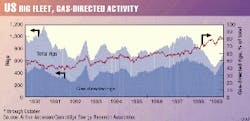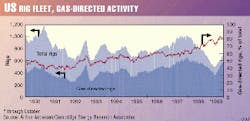The North American natural gas sector will experience unprecedented growth over the coming decade, with increasing demand coming mostly from growing needs in the power generation sector. That the industry will be able to meet this increased demand in the coming decade is evident, in part, through a steady increase in gas-directed drilling in the US.
These were some of the key findings of a joint study on North American natural gas trends by Arthur Andersen and Cambridge Energy Research Associates (CERA).
Consolidations will continue to dominate the industry, moving from the integrated and upstream sectors to the midstream and energy distribution sectors, the companies predict. In addition, the revolution occurring in information technology (IT) and electronic commerce (e-commerce) could alter the way energy is used and to ensure reliable delivery.
The 30 tcf market
Since 1998, much has been made of the projected growth in the US natural gas market to 30 tcf/year by 2010-15, says Everett Gibbs, managing director, natural gas services for Arthur Andersen. "And, although not serving as a focal point for this analysis, it cannot be ignored," he said.
"A 30 tcf market would require us effectively to replace our existing reserve base [of about 300 tcf] over the next decade. Including infrastructure investments, the gas industry could find itself risking as much as $500 billion in capital in a more volatile and unpredictable marketplace."
As the demand for natural gas for the power industry has grown, he says, many industry insiders have become convinced that the 30 tcf market will become a reality. "We do anticipate that there will be a few bumps, so to speak, in the path," he added.
Increased use of natural gas for power generation could double the estimated 5 tcf/year used in the sector, and this increase alone could catapult North American consumption from 26 tcf in 1998 to 30 tcf, Gibbs says.
According to the study, about 15% of the current installed power generation base is gas-fired, while over 80% of all planned capacity is gas-fired. This is primarily because gas is seen as the fuel of choice, as it meets increasingly stringent emissions limits. But gas-fired and combined-cycle plants also entail low capital costs, he adds.
"It's virtually predetermined that the penetration of gas into the power sector will accelerate," said Gibbs. This makes it easy to envision a 4-6 tcf increase in annual demand by 2010.
Gas drilling
During the 1990s, the number of drilling rigs active in the US has fluctuated between 600 and 1,200, while gas-directed drilling has risen steadily (see chart).
"With gas commanding a significantly greater role in the North American energy mix," says the report, "the proportion of drilling activity directed toward gas has increased steadily throughout the 1990s. Gas-directed drilling utilized less than half of the rig fleet in the early part of this decade, but usage increased to over 80% in the third quarter of 1999.
"Some of this recent increased dominance of gas is related to a slow response to increased world oil prices and a lack of renewed oil-directed drilling to-date by the E&P sector," said the report. But expected further increases in North American gas drilling will go a long way toward ensuring that growing US gas demand is met.
Increased consolidation
The very structure of the natural gas industry will continue to be altered over the coming decade, fueled by continuing waves of consolidation, says Thomas Robinson, CERA managing director and director of research. "It's going to be volatile and unpredictable in the decade ahead," he said.
One of the core sectors that will see the most consolidation activity will be energy distribution, says Robinson.
"What we're really talking about for the next 5 years is going to be a lot more emphasis on bulking up our existing system [and] improving utilization," he said.
Playing a part in this improved utilization, and perhaps serving as one of the more "significant surprises" in the near future, will be the major investment in connecting new frontiers of gas supply to the existing grid. Robinson notes, "Our challenge is not one of having enough supply, it's a question of when and at what level, what priceellipse and where it comes from. As you look longer-term, [there may] even [be] the possibility of a major project over the next decade that connects Arctic gas into [the North American] grid," Robinson said.
During the 1990s, Robinson notes, the upstream sector was very much involved in a period of rationalization. This rationalization has shifted over the last 10 years to the gas transmission sector, he says. "...Ten years ago, the largest gas pipeline had throughput of about 6.6 bcfd...At the end of the decade, the largest pipeline group was twice that size, and being 6.6 wouldn't even put you in the top 5."
During that same period, the industry also witnessed the entry of major new power entities into the gas transmission business-many of which were not even significant players at the start of the 1990s. "Nowellipsewith the El Paso-Coastal pending merger [OGJ, Jan. 24, 2000, p. 23], we'll see the largest companies grow to over 20 bcfd. Some of that will continue, but we obviously may have reached the limit to how far we can go in terms of building these national grids of transmission infrastructure," said Robinson.
Since 1997, Robinson adds, the industry has seen over 30 mergers in the energy distribution sector-a majority of them involving gas distribution companies merging with electric distribution companies (see related story, p. 34).
E-commerce forces
One of the more significant forces prompting changes in the gas sector are the growing IT and e-commerce businesses, says Robinson. But this wave of change has a stronger hold on the broader energy value chain than on gas specifically.
The energy industry has been somewhat slow to embrace the shift, says Robinson, largely due to the speed at which industry has opened up to such programs as retail choice.
"Longer-term, and being more speculative, the real impact to look for is what effect will IT have on what goes on behind the meter?...I'm going to speculate that IT, more than anything else, has the potential to force us to rethink the energy value chainellipsefrom the customer back upstream...This will force customer focus," said Robinson.



